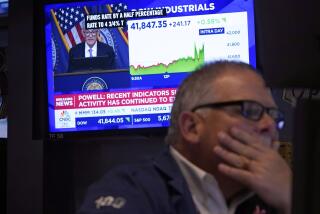Federal Reserve again reduces bond purchases, keeps key rate near zero
WASHINGTON -- Federal Reserve policymakers voted Wednesday to continue reducing their bond-buying stimulus program and said they no longer would consider raising its near-zero interest rate once the unemployment rate fell below 6.5%.
The Federal Open Market Committee voted 8-1 to cut its monthly bond purchases to $55 billion, staying on pace to end the controversial program by the end of the year. The economy grew slower this winter, but that was partly because of bad weather.
Still, Fed officials downgraded their growth projections. They estimated the economy would expand at a rate of 2.8% to 3% this year, down from the December projection of 2.8% to 3.2%.
PHOTOS: Federal Reserve chairs through the years
But Fed policymakers improved their outlook on the unemployment rate, forecasting it would drop as low as 6.1% by the end of the year compared to a December projected low of 6.3%.
With the unemployment rate falling faster than anticipated, Fed officials revised their so-called forward guidance on interest rates.
The committee removed a reference in previous statements to keeping the central bank’s benchmark interest rate near zero as long as the unemployment rate was above 6.5%.
Fed policymakers said in their statement that they took the step because the unemployment rate was nearing that point -- it was 6.7% in February.
But the statement said the revision “does not indicate any change in the committee’s policy intentions.”
The policy statement was the first for the Federal Open Market Committee since Janet L. Yellen took over as central bank chairwoman on Feb. 3.
After presiding over her initial two-day committee meeting this week, Yellen was scheduled to give her first news conference Wednesday to explain the Fed’s actions and answer questions.
The statement said data since the committee last met in January “indicates that growth in economic activity slowed during the winter months, in part reflecting adverse weather conditions.”
“Labor market indicators were mixed but on balance showed further improvement,” the Fed said. “The unemployment rate, however, remains elevated.”
Fed officials said in December they would taper the central bank’s $85 billion in monthly bond purchases by $10 billion and continue reducing the program “in measured steps” at future meetings if the outlook for the labor market continued to improve and inflation remained in check.
The Fed reduced the purchases by $10 billion again in January, and the policy committee did not meet in February.
Some weak economic data this winter, including lackluster job creation in December and January, led to concerns that the recovery was weakening and speculation that Fed officials might hold off on further stimulus reductions.
But job growth rebounded in February, and some other recent reports indicated the slowdown was related to unusually harsh winter weather.
The Fed’s benchmark short-term interest rate has been near zero since late 2008.
In December 2012, with the unemployment rate at 7.8%, central bank policymakers said it would stay there at least as long as the rate remained above 6.5%. Last December, Fed officials amplified that by saying they probably would keep the interest rate near zero “well past the time” that the unemployment rate drops below 6.5%.
But the unemployment rate fell through most of last year and was at 6.7% in February.
With the potential for the rate to fall below 6.5% soon, there was much speculation before the announcement that Fed policymakers would revise their so-called forward guidance.
More to Read
Inside the business of entertainment
The Wide Shot brings you news, analysis and insights on everything from streaming wars to production — and what it all means for the future.
You may occasionally receive promotional content from the Los Angeles Times.











